User:Maxmead2/sandbox
Commonwealth of Australia | |
|---|---|
| Anthem: "Advance Australia Fair"[N 1] | |
 | |
| Capital | Canberra 35°18′29″S 149°07′28″E / 35.30806°S 149.12444°E |
| Largest city | Sydney |
| National language | English[N 2] |
| Demonym(s) |
|
| Government | Federal parliamentary constitutional monarchy |
• Monarch | Elizabeth II |
| Sir Peter Cosgrove | |
| Malcolm Turnbull | |
| Michael McCormack | |
| Susan Kiefel | |
| Scott Ryan | |
| Tony Smith | |
| Legislature | Parliament |
| Senate | |
| House of Representatives | |
| Independence from the United Kingdom | |
| 1 January 1901 | |
| 9 October 1942 (with effect from 3 September 1939) | |
| 3 March 1986 | |
+61 | |
| ISO 3166 code | AU |
| Internet TLD | .au |
Australia (/əˈstreɪliə, ɒ-/ ⓘ),[10][11] officially the Commonwealth of Australia,[12] is a sovereign country comprising the mainland of the Australian continent, the island of Tasmania and numerous smaller islands. It is the largest country in Oceania and the world's sixth-largest country by total area. The neighbouring countries are Papua New Guinea, Indonesia and East Timor to the north; the Solomon Islands and Vanuatu to the north-east; and New Zealand to the south-east. Australia's capital is Canberra, and its largest city is Sydney.
For about 60,000 years before the first
Australia has the world's
Name
The name Australia (pronounced [əˈstɹæɪljə, -liə] in Australian English[18]) is derived from the Latin Terra Australis ("southern land"), a name used for a hypothetical continent in the Southern Hemisphere since ancient times.[19] When Europeans first began visiting and mapping Australia in the 17th century, the name Terra Australis was naturally applied to the new territories.[N 4]
Until the early 19th century, Australia was best known as "New Holland", a name first applied by the Dutch explorer Abel Tasman in 1644 (as Nieuw-Holland) and subsequently anglicised. Terra Australis still saw occasional usage, such as in scientific texts.[N 5] The name Australia was popularised by the explorer Matthew Flinders, who said it was "more agreeable to the ear, and an assimilation to the names of the other great portions of the earth".[25] The first time that Australia appears to have been officially used was in April 1817, when Governor Lachlan Macquarie acknowledged the receipt of Flinders' charts of Australia from Lord Bathurst.[26] In December 1817, Macquarie recommended to the Colonial Office that it be formally adopted.[27] In 1824, the Admiralty agreed that the continent should be known officially by that name.[28] The first official published use of the new name came with the publication in 1830 of The Australia Directory by the Hydrographic Office.[29]
Colloquial names for Australia include "Oz" and "the Land Down Under" (usually shortened to just "Down Under"). Other epithets include "the Great Southern Land", "the Lucky Country", "the Sunburnt Country", and "the Wide Brown Land". The latter two both derive from Dorothea Mackellar's 1908 poem "My Country".[30]
History
Pre-colonial history
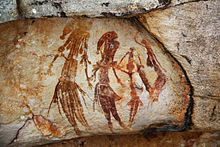
Human habitation of the Australian continent is estimated to have begun around 65,000 to 70,000 years ago,
European arrival
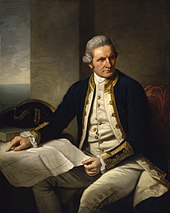
The first recorded European sighting of the Australian mainland, and the first recorded European landfall on the Australian continent (in 1606), are attributed to the Dutch. The first ship and crew to chart the Australian coast and meet with Aboriginal people was the
With the loss of its American colonies in 1783, the British Government sent a fleet of ships, the "First Fleet", under the command of Captain Arthur Phillip, to establish a new penal colony in New South Wales. A camp was set up and the flag raised at Sydney Cove, Port Jackson, on 26 January 1788,[40] a date which became Australia's national day, Australia Day, although the British Crown Colony of New South Wales was not formally promulgated until 7 February 1788. The first settlement led to the foundation of Sydney, and the exploration and settlement of other regions.[citation needed]
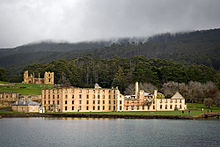
A British settlement was established in
The indigenous population, estimated to have been between 750,000 and 1,000,000 in 1788,
Colonial expansion
A gold rush began in Australia in the early 1850s[55] and the Eureka Rebellion against mining licence fees in 1854 was an early expression of civil disobedience.[56] Between 1855 and 1890, the six colonies individually gained responsible government, managing most of their own affairs while remaining part of the British Empire.[57] The Colonial Office in London retained control of some matters, notably foreign affairs,[58] defence,[59] and international shipping.
Nationhood
On 1 January 1901,
Britain's
Geography
General characteristics

Australia's landmass of 7,617,930 square kilometres (2,941,300 sq mi)
The Great Barrier Reef, the world's largest coral reef,[90] lies a short distance off the north-east coast and extends for over 2,000 kilometres (1,240 mi). Mount Augustus, claimed to be the world's largest monolith,[91] is located in Western Australia. At 2,228 metres (7,310 ft), Mount Kosciuszko on the Great Dividing Range is the highest mountain on the Australian mainland. Even taller are Mawson Peak (at 2,745 metres or 9,006 feet), on the remote Australian territory of Heard Island, and, in the Australian Antarctic Territory, Mount McClintock and Mount Menzies, at 3,492 metres (11,457 ft) and 3,355 metres (11,007 ft) respectively.[92]
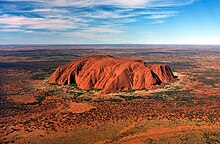
Australia's size gives it a wide variety of landscapes, with tropical rainforests in the north-east, mountain ranges in the south-east, south-west and east, and dry desert in the centre.[93] It is the flattest continent,[94] with the oldest and least fertile soils;[95][96] desert or semi-arid land commonly known as the outback makes up by far the largest portion of land.[97] Australia is the driest inhabited continent; its annual rainfall averaged over continental area is less than 500 mm.[98] The population density, 2.8 inhabitants per square kilometre, is among the lowest in the world,[99] although a large proportion of the population lives along the temperate south-eastern coastline.[100]
Eastern Australia is marked by the Great Dividing Range, which runs parallel to the coast of Queensland, New South Wales and much of Victoria. The name is not strictly accurate, because parts of the range consist of low hills, and the highlands are typically no more than 1,600 metres (5,249 ft) in height.[101] The coastal uplands and a belt of Brigalow grasslands lie between the coast and the mountains, while inland of the dividing range are large areas of grassland.[101][102] These include the western plains of New South Wales, and the Einasleigh Uplands, Barkly Tableland, and Mulga Lands of inland Queensland. The northernmost point of the east coast is the tropical-rainforested Cape York Peninsula.[103][104][105][106]
The landscapes of the
Climate

| Equatorial Tropical Subtropical | Desert Grassland Temperate |
The climate of Australia is significantly influenced by ocean currents, including the
According to the
Australia's carbon dioxide emissions per capita are among the highest in the world, lower than those of only a few other industrialised nations.[125] A carbon tax was introduced in 2012 and helped to reduce Australia's emissions but was scrapped in 2014 under the Liberal Government.[126] Since the carbon tax was repealed, emissions have again continued to rise.[127]
Biodiversity
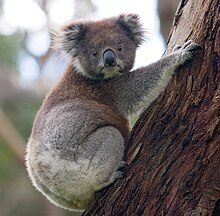
Although most of Australia is semi-arid or desert, it includes a diverse range of habitats from
Australian forests are mostly made up of evergreen species, particularly eucalyptus trees in the less arid regions; wattles replace them as the dominant species in drier regions and deserts.[132] Among well-known Australian animals are the monotremes (the platypus and echidna); a host of marsupials, including the kangaroo, koala, and wombat, and birds such as the emu and the kookaburra.[132] Australia is home to many dangerous animals including some of the most venomous snakes in the world.[133] The dingo was introduced by Austronesian people who traded with Indigenous Australians around 3000 BCE.[134] Many animal and plant species became extinct soon after first human settlement,[135] including the Australian megafauna; others have disappeared since European settlement, among them the thylacine.[136][137]
Many of Australia's ecoregions, and the species within those regions, are threatened by human activities and introduced animal, chromistan, fungal and plant species.[138] All these factors have led to Australia's having the highest mammal extinction rate of any country in the world.[139] The federal Environment Protection and Biodiversity Conservation Act 1999 is the legal framework for the protection of threatened species.[140] Numerous protected areas have been created under the National Strategy for the Conservation of Australia's Biological Diversity to protect and preserve unique ecosystems;[141][142] 65 wetlands are listed under the Ramsar Convention,[143] and 16 natural World Heritage Sites have been established.[144] Australia was ranked 3rd out of 178 countries in the world on the 2014 Environmental Performance Index.[145]
Government and politics
Australia is a federal parliamentary constitutional monarchy[146] with Elizabeth II at its apex as the Queen of Australia, a role that is distinct from her position as monarch of the other Commonwealth realms. The Queen is represented in Australia by the Governor-General at the federal level and by the Governors at the state level, who by convention act on the advice of her ministers.[147][148] Thus, in practice the Governor-General has no actual decision-making or de facto governmental role, and merely acts as a legal figurehead for the actions of the Prime Minister and the Federal Executive Council. The Governor-General does have extraordinary reserve powers which may be exercised outside the Prime Minister's request in rare and limited circumstances, the most notable exercise of which was the dismissal of the Whitlam Government in the constitutional crisis of 1975.[149]
The federal government is separated into three branches:
- Legislature: the bicameral Parliament, defined in section 1 of the constitution as comprising the Queen (represented by the Governor-General), the Senate, and the House of Representatives;
- Executive: the Federal Executive Council, which in practice gives legal effect to the decisions of the cabinet, comprising the prime minister and ministers of state who advise the Governor-General;[150]
- Judiciary: the federal courts, whose judges are appointed by the Governor-General on advice of the Federal Executive Council.
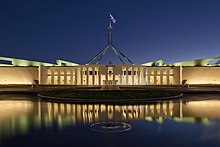
In the Senate (the upper house), there are 76 senators: twelve each from the states and two each from the mainland territories (the Australian Capital Territory and the Northern Territory).[151] The House of Representatives (the lower house) has 150 members elected from single-member electoral divisions, commonly known as "electorates" or "seats", allocated to states on the basis of population,[152] with each original state guaranteed a minimum of five seats.[153] Elections for both chambers are normally held every three years simultaneously; senators have overlapping six-year terms except for those from the territories, whose terms are not fixed but are tied to the electoral cycle for the lower house; thus only 40 of the 76 places in the Senate are put to each election unless the cycle is interrupted by a double dissolution.[151]
Australia's electoral system uses preferential voting for all lower house elections with the exception of Tasmania and the ACT which, along with the Senate and most state upper houses, combine it with proportional representation in a system known as the single transferable vote. Voting is compulsory for all enrolled citizens 18 years and over in every jurisdiction,[154] as is enrolment (with the exception of South Australia).[155] The party with majority support in the House of Representatives forms the government and its leader becomes Prime Minister. In cases where no party has majority support, the Governor-General has the constitutional power to appoint the Prime Minister and, if necessary, dismiss one that has lost the confidence of Parliament.[156]
There are two major political groups that usually form government, federally and in the states: the
In September 2015,
States and territories
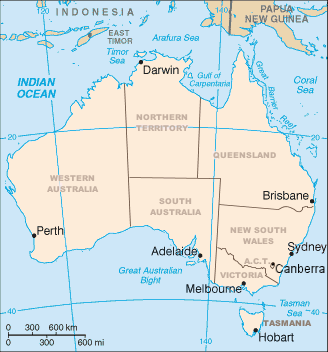
Australia has six states—
Under the constitution, the States essentially have
Each state and major mainland territory has its own
The Commonwealth Parliament also directly administers the following external territories: Ashmore and Cartier Islands; Australian Antarctic Territory; Christmas Island; Cocos (Keeling) Islands; Coral Sea Islands; Heard Island and McDonald Islands; and Jervis Bay Territory, a naval base and sea port for the national capital in land that was formerly part of New South Wales.[150] The external territory of Norfolk Island previously exercised considerable autonomy under the Norfolk Island Act 1979 through its own legislative assembly and an Administrator to represent the Queen.[167] In 2015, the Commonwealth Parliament abolished self-government, integrating Norfolk Island into the Australian tax and welfare systems and replacing its legislative assembly with a council.[168] Macquarie Island is administered by Tasmania, and Lord Howe Island by New South Wales.
Foreign relations

Over recent decades,
Along with New Zealand, the United Kingdom, Malaysia and Singapore, Australia is party to the Five Power Defence Arrangements, a regional defence agreement. A founding member country of the United Nations, Australia is strongly committed to multilateralism[181] and maintains an international aid program under which some 60 countries receive assistance. The 2005–06 budget provides A$2.5 billion for development assistance.[182] Australia ranks fifteenth overall in the Center for Global Development's 2012 Commitment to Development Index.[183]
Military

Australia's armed forces—the
In the 2016–17 budget, defence spending comprised 2% of GDP, representing the world's
Economy

Australia is a wealthy country; it generates its income from various sources including mining-related exports, telecommunications, banking and manufacturing.[188][189][190] It has a market economy, a relatively high GDP per capita, and a relatively low rate of poverty. In terms of average wealth, Australia ranked second in the world after Switzerland in 2013, although the nation's poverty rate increased from 10.2% to 11.8%, from 2000/01 to 2013.[191][192] It was identified by the Credit Suisse Research Institute as the nation with the highest median wealth in the world and the second-highest average wealth per adult in 2013.[191]
The
Ranked fifth in the

An emphasis on exporting commodities rather than manufactured goods has underpinned a significant increase in Australia's terms of trade since the start of the 21st century, due to rising commodity prices. Australia has a balance of payments that is more than 7% of GDP negative, and has had persistently large current account deficits for more than 50 years.[203] Australia has grown at an average annual rate of 3.6% for over 15 years, in comparison to the OECD annual average of 2.5%.[203]
Australia was the only advanced economy not to experience a recession due to the
The
In May 2012, there were 11,537,900 people employed (either full- or part-time), with an unemployment rate of 5.1%.
Since 2008, inflation has typically been 2–3% and the base interest rate 5–6%. The service sector of the economy, including tourism, education, and financial services, accounts for about 70% of GDP.[218] Rich in natural resources, Australia is a major exporter of agricultural products, particularly wheat and wool, minerals such as iron-ore and gold, and energy in the forms of liquified natural gas and coal. Although agriculture and natural resources account for only 3% and 5% of GDP respectively, they contribute substantially to export performance. Australia's largest export markets are Japan, China, the US, South Korea, and New Zealand.[219] Australia is the world's fourth largest exporter of wine, and the wine industry contributes A$5.5 billion per year to the nation's economy.[220]
Demography

Until the
Australia's population has quadrupled since the end of World War I,[223] much of this increase from immigration. Following World War II and through to 2000, almost 5.9 million new immigrants arrived and settled in the country.[224] Most immigrants are skilled,[225] but the immigration quota includes categories for family members and refugees.[225] By 2050, Australia's population is currently projected to reach around 42 million.[226] Nevertheless, its population density, 2.8 inhabitants per square kilometre, remains among the lowest in the world.[99]
In 2016, more than a quarter (26%) of Australia's population were born overseas; the five largest immigrant groups were those born in England (3.9%), New Zealand (2.2%), Mainland China (2.2%), India (1.9%), and the Philippines (1%).[227] Following the abolition of the White Australia policy in 1973, numerous government initiatives have been established to encourage and promote racial harmony based on a policy of multiculturalism.[228] In 2015–16, there were 189,770 permanent immigrants admitted to Australia, mainly from Asia.[229]
The Indigenous population—Aborigines and Torres Strait Islanders—was counted at 649,171 (2.8% of the total population) in 2016.[230] The increase is partly due to many people with Indigenous heritage previously having been overlooked by the census due to undercount and cases where their Indigenous status had not been recorded on the form. Indigenous Australians experience higher than average rates of imprisonment and unemployment, lower levels of education, and life expectancies for males and females that are, respectively, 11 and 17 years lower than those of non-indigenous Australians.[219][231][232] Some remote Indigenous communities have been described as having "failed state"-like conditions.[233]
In common with many other developed countries, Australia is experiencing a demographic shift towards an older population, with more retirees and fewer people of working age. In 2004, the average age of the civilian population was 38.8 years.[234] A large number of Australians (759,849 for the period 2002–03;[235] 1 million or 5% of the total population in 2005[236]) live outside their home country.
| Rank | Name | State | Pop. | Rank | Name | State | Pop. | ||
|---|---|---|---|---|---|---|---|---|---|
| 1 | Sydney | NSW | 5,259,764 | 11 | Geelong | Vic | 289,400 | ||
| 2 | Melbourne | Vic | 4,976,157 | 12 | Hobart | Tas | 251,047 | ||
| 3 | Brisbane | Qld | 2,568,927 | 13 | Townsville | Qld | 181,665 | ||
| 4 | Perth | WA | 2,192,229 | 14 | Cairns | Qld | 155,638 | ||
| 5 | Adelaide | SA | 1,402,393 | 15 | Darwin | NT | 148,801 | ||
| 6 | Tweed Heads |
Qld/NSW | 706,673 | 16 | Toowoomba | Qld | 143,994 | ||
| 7 | Newcastle–Maitland | NSW | 509,894 | 17 | Ballarat | Vic | 111,702 | ||
| 8 | Canberra–Queanbeyan | ACT/NSW | 482,250 | 18 | Bendigo | Vic | 102,899 | ||
| 9 | Sunshine Coast | Qld | 355,631 | 19 | Albury-Wodonga |
NSW/Vic | 97,676 | ||
| 10 | Wollongong | NSW | 305,880 | 20 | Launceston | Tas | 93,332 | ||
Language
Although Australia has no official language, English has always been entrenched as the
According to the 2016 census, English is the only language spoken in the home for close to 72.7% of the population. The next most common languages spoken at home are
A considerable proportion of first- and second-generation migrants are bilingual.Over 250
Religion
Australia has no
Before European settlement, the animist beliefs of Australia's indigenous people had been practised for many thousands of years. Mainland
Since the arrival of the First Fleet of British ships in 1788, Christianity has grown to be the major religion practised in Australia. Christian churches have played an integral role in the development of education, health and welfare services in Australia. For much of Australian history, the Church of England (now known as the Anglican Church of Australia) was the largest religious denomination. However, multicultural immigration has contributed to a decline in its relative position, and the Roman Catholic Church has benefitted from recent immigration to become the largest group. Similarly, Islam, Buddhism, Hinduism and Judaism have all grown in Australia over the past half-century.[249]
Australia has one of the lowest levels of religious adherence in the world.[250] In 2001, only 8.8% of Australians attended church on a weekly basis.[251]
Health
Australia has the third and seventh highest life expectancy of males and females respectively in the world.[252] Life expectancy in Australia in 2010 was 79.5 years for males and 84.0 years for females.[253] Australia has the highest rates of skin cancer in the world,[254] while cigarette smoking is the largest preventable cause of death and disease, responsible for 7.8% of the total mortality and disease. Ranked second in preventable causes is hypertension at 7.6%, with obesity third at 7.5%.[255][256] Australia ranks 35th in the world[257] and near the top of developed nations for its proportion of obese adults[258] and nearly two thirds (63%) of its adult population is either overweight or obese.[259]
Total expenditure on health (including private sector spending) is around 9.8% of GDP.
Education

School attendance, or registration for home schooling,[264] is compulsory throughout Australia. Education is the responsibility of the individual states and territories[265] so the rules vary between states, but in general children are required to attend school from the age of about 5 until about 16.[266][267] In some states (e.g., Western Australia,[268] the Northern Territory[269] and New South Wales[270][271]), children aged 16–17 are required to either attend school or participate in vocational training, such as an apprenticeship.
Australia has an adult literacy rate that was estimated to be 99% in 2003.
Australia has 37 government-funded universities and two private universities, as well as a number of other specialist institutions that provide approved courses at the higher education level.[274] The OECD places Australia among the most expensive nations to attend university.[275] There is a state-based system of vocational training, known as TAFE, and many trades conduct apprenticeships for training new tradespeople.[276] About 58% of Australians aged from 25 to 64 have vocational or tertiary qualifications,[219] and the tertiary graduation rate of 49% is the highest among OECD countries. The ratio of international to local students in tertiary education in Australia is the highest in the OECD countries.[277] In addition, 30.9 percent of Australia's population has attained a higher education qualification, which is among the highest percentages in the world.[278][279][280]
Culture
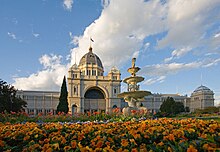
Since 1788, the primary influence behind Australian culture has been Anglo-Celtic Western culture, with some Indigenous influences.[282][283] The divergence and evolution that has occurred in the ensuing centuries has resulted in a distinctive Australian culture.[284][285] Since the mid-20th century, American popular culture has strongly influenced Australia, particularly through television and cinema.[286] Other cultural influences come from neighbouring Asian countries, and through large-scale immigration from non-English-speaking nations.[286][287]
Arts
Indigenous Australian rock art is the oldest and richest in the world, dating as far back as 60,000 years and spread across hundreds of thousands of sites.[288] Traditional designs, patterns and stories infuse contemporary Indigenous Australian art, "the last great art movement of the 20th century";[289] its exponents include Emily Kame Kngwarreye.[290] Early colonial artists, trained in Europe, showed a fascination with the unfamiliar land.[291] The impressionistic works of Arthur Streeton, Tom Roberts and others associated with the 19th-century Heidelberg School—the first "distinctively Australian" movement in Western art—gave expression to a burgeoning Australian nationalism in the lead-up to Federation.[291] While the school remained influential into the new century, modernists such as Margaret Preston, and, later, Sidney Nolan and Arthur Boyd, explored new artistic trends.[291] The landscape remained a central subject matter for Fred Williams, Brett Whiteley and other post-World War II artists whose works, eclectic in style yet uniquely Australian, moved between the figurative and the abstract.[291][292] The national and state galleries maintain collections of local and international art.[293] Australia has one of the world's highest attendances of art galleries and museums per head of population.[294]
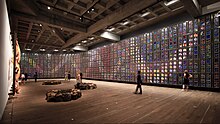
Many of Australia's performing arts companies receive funding through the federal government's
Media
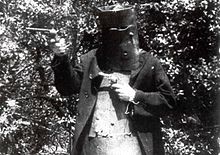
Australia has two public broadcasters (the
Cuisine
Most Indigenous Australian tribal groups subsisted on a simple
is produced mainly in the southern, cooler parts of the country.Australia is also known for its cafe and coffee culture in urban centres, which has influenced coffee culture abroad, including New York City.[326] Australia and New Zealand were responsible for the flat white coffee.
Sport and recreation
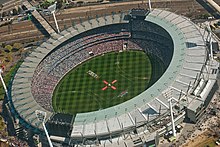
About 24% of Australians over the age of 15 regularly participate in organised sporting activities.[219]
Australia is unique in that it has professional leagues for four football codes. Australian rules football, the world's oldest major football code and Australia's most popular sport in terms of revenue and spectatorship, originated in Melbourne in the late 1850s, and predominates in all states except New South Wales and Queensland, where rugby league holds sway, followed by rugby union. Soccer, while ranked fourth in popularity and resources, has the highest overall participation rates.[328]
The Australian national cricket team have participated in every edition of the Cricket World Cup. Australia have been very successful in the event, winning the tournament five times, the record number.[329]
Australia is a powerhouse in water-based sports, such as swimming and surfing.[330] The surf lifesaving movement originated in Australia, and the volunteer lifesaver is one of the country's icons.[331] Nationally, other popular sports include horse racing, basketball, and motor racing. The annual Melbourne Cup horse race and the Sydney to Hobart yacht race attract intense interest.[332] In 2016, the Australian Sports Commission revealed that swimming, cycling and soccer are the three most popular participation sports.[333][334]
Australia is one of five nations to have participated in every
See also
Notes
- God Save the Queen", played in the presence of a member of the Royal family when they are in Australia. In other contexts, the national anthem of Australia, "Advance Australia Fair", is played.[1]
- ^ English does not have de jure status.[2]
- ^ a b There are minor variations from three basic time zones; see Time in Australia.
- ^ The earliest recorded use of the word Australia in English was in 1625 in "A note of Australia del Espíritu Santo, written by Sir Richard Hakluyt", published by Samuel Purchas in Hakluytus Posthumus, a corruption of the original Spanish name "Austrialia del Espíritu Santo" (Southern Land of the Holy Spirit)[20][21][22] for an island in Vanuatu.[23] The Dutch adjectival form australische was used in a Dutch book in Batavia (Jakarta) in 1638, to refer to the newly discovered lands to the south.[24]
- ^ For instance, the 1814 work A Voyage to Terra Australis.
- ^ Australia describes the body of water south of its mainland as the Southern Ocean, rather than the Indian Ocean as defined by the International Hydrographic Organization (IHO). In 2000, a vote of IHO member nations defined the term "Southern Ocean" as applying only to the waters between Antarctica and 60 degrees south latitude.[83]
- ^ Based on the Köppen climate classification.
References
- ^ It's an Honour – Symbols – Australian National Anthem Archived 9 November 2007 at the Wayback Machine and DFAT – "Australian National Anthem" Archived 23 September 2015 at the Wayback Machine; "National Symbols" (PDF). Parliamentary Handbook of the Commonwealth of Australia (PDF) (29th ed.). 2005 [2002] (PDF). Retrieved 7 June 2007.
{{cite book}}: Check|archiveurl=value (help) - ^ a b "Pluralist Nations: Pluralist Language Policies?". 1995 Global Cultural Diversity Conference Proceedings, Sydney. Department of Immigration and Citizenship. Archived from the original on 20 December 2008. Retrieved 11 January 2009. "English has no de jure status but it is so entrenched as the common language that it is de facto the official language as well as the national language."
- ^ See entry in the Macquarie Dictionary.
- ISBN 978-0-00-786171-2.
- ^ a b "Population clock". Australian Bureau of Statistics website. Commonwealth of Australia. Retrieved 3 April 2018. The population estimate shown is automatically calculated daily at 00:00 UTC and is based on data obtained from the population clock on the date shown in the citation.
- ^ Australian Bureau of Statistics (27 June 2017). "Australia". 2016 Census QuickStats. Retrieved 27 June 2017.
- ^ a b c d "Australia". International Monetary Fund. April 2018. Retrieved 22 April 2018.
- ^ "OECD Economic Surveys: Norway 2012".
- ^ "2016 Human Development Report" (PDF). United Nations Development Programme. 2016. Retrieved 23 March 2017.
- ISBN 1-876429-37-2.
- ^ "Australia". Oxford Dictionaries. Oxford University Press. April 2010. Retrieved 26 July 2012.
- ComLaw. 9 July 1900. Retrieved 5 August 2011.
3. It shall be lawful for the Queen, with the advice of the Privy Council, to declare by proclamation that, on and after a day therein appointed, not being later than one year after the passing of this Act, the people of New South Wales, Victoria, South Australia, Queensland, and Tasmania, and also, if Her Majesty is satisfied that the people of Western Australia have agreed thereto, of Western Australia, shall be united in a Federal Commonwealth under the name of the Commonwealth of Australia.
- ^ Data refer mostly to the year 2014. World Economic Outlook Database-April 2015, International Monetary Fund. Accessed on 25 April 2015.
- ^ "Australia: World Audit Democracy Profile". WorldAudit.org. Archived from the original on 13 December 2007. Retrieved 5 January 2008.
- ^ "Geographic Distribution of the Population". Retrieved 1 December 2012.
- ^ Statistics, c=AU; o=Commonwealth of Australia; ou=Australian Bureau of. "Main Features — Cultural Diversity Article". www.abs.gov.au.
{{cite web}}: CS1 maint: multiple names: authors list (link) - ^ United Nations, Department of Economic and Social Affairs, Population Division, (2015). 'International Migration' in International migrant stock 2015. Accessed from International migrant stock 2015: maps on 24 May 2017.
- ISBN 1-876429-14-3
- ^ "Australia" Archived 23 December 2016 at the Wayback Machine – Online Etymology Dictionary. Retrieved 28 October 2015.
- ^ "He named it Austrialia del Espiritu Santo and claimed it for Spain" Archived 17 August 2013 at the Wayback Machine The Spanish quest for Terra Australis | State Library of New South Wales Page 1.
- ^ "A note on 'Austrialia' or 'Australia' Rupert Gerritsen – Journal of The Australian and New Zealand Map Society Inc.- The Globe, Number 72, 2013 " Archived 12 June 2016 at the Wayback Machine Posesion en nombre de Su Magestad (Archivo del Museo Naval, Madrid, MS 951) Page 3.
- ^ "THE ILLUSTRATED SYDNEY NEWS". Illustrated Sydney News. National Library of Australia. 26 January 1888. p. 2. Retrieved 29 January 2012.
- ^ Purchas, vol. iv, pp. 1422–32, 1625. This appears to be variation of the original Spanish "Austrialia" [sic].[1] A copy at the Library of Congress can be read online "Archived copy". Archived from the original on 14 September 2016. Retrieved 14 July 2015.
{{cite web}}: CS1 maint: archived copy as title (link). - ISBN 978-1-4191-6948-9.
- ^ Flinders, Matthew (1814). A Voyage to Terra Australis. G. and W. Nicol.
- The Mail (Adelaide, SA : 1912 – 1954). Adelaide: National Library of Australia. 11 February 1928. p. 16. Retrieved 14 February 2012.
- ^ Weekend Australian, 30–31 December 2000, p. 16
- ISBN 978-1-921446-30-6. Archived from the original(PDF) on 17 October 2009. Retrieved 30 March 2010.
- ^ Brian J. Coman A Loose Cannon, Essays on History, Modernity and Tradition, Ch. 5, "La Austrialia del Espiritu Santo: Captain Quiros and the Discovery of Australia in 1606", p. 40. Retrieved 16 February 2017
- ^ Meanings and origins of Australian words and idioms, ANU
- S2CID 205257212.
- ^ ISBN 978-90-481-8891-8.
- ^ "The spread of people to Australia". Australian Museum.
- ^ Viegas, Jennifer (3 July 2008). "Early Aussie Tattoos Match Rock Art". Discovery News. Archived from the original on 10 July 2008. Retrieved 30 March 2010.
- Melbourne University Press.
- ^ "European discovery and the colonisation of Australia — European mariners". Government of Australia. Government of Australia. 2015. Retrieved 12 February 2017.
- ^ a b Davison, Hirst and Macintyre, p. 233.
- ISBN 978-1-86397-798-2.
- ^ "European discovery and the colonisation of Australia". Australian Government: Culture Portal. Department of the Environment, Water, Heritage and the Arts, Commonwealth of Australia. 11 January 2008. Archived from the original on 16 February 2011.
- ^ "European discovery and the colonisation of Australia". Australian Government: Culture Portal. Department of the Environment, Water, Heritage and the Arts, Commonwealth of Australia. 11 January 2008. Retrieved 7 May 2010.
[The British] moved north to Port Jackson on 26 January 1788, landing at Camp Cove, known as 'cadi' to the Cadigal people. Governor Phillip carried instructions to establish the first British Colony in Australia. The First Fleet was under prepared for the task, and the soil around Sydney Cove was poor.
- ^ Davison, Hirst and Macintyre, pp. 464–5, 628–29.
- ^ Davison, Hirst and Macintyre, p. 678.
- ^ Davison, Hirst and Macintyre, p. 464.
- ^ Davison, Hirst and Macintyre, p. 470.
- ^ Davison, Hirst and Macintyre, p. 598.
- ^ Davison, Hirst and Macintyre, p. 679.
- ^ Convict Records Public Record office of Victoria; State Records Office of Western Australia Archived 30 May 2012 at the Wayback Machine.
- ^ "1998 Special Article – The State of New South Wales – Timeline of History". Australian Bureau of Statistics. 1988.
- ISBN 978-0-9585637-6-5.
- ^ Smallpox Through History. Archived from the original on 31 October 2009.
{{cite encyclopedia}}:|work=ignored (help) - ISBN 9781876944117, p. 89.
- ISBN 1-74114-577-5.
- ^ Dawkins, Kezia (1 February 2004). "1967 Referendum". Australian Broadcasting Corporation. Archived from the original on 20 April 2010. Retrieved 30 March 2010.
- ^ Davison, Hirst and Macintyre, pp. 5–7, 402.
- ^ Davison, Hirst and Macintyre, pp. 283–85.
- ^ Davison, Hirst and Macintyre, pp. 227–9.
- ^ Davison, Hirst and Macintyre, p. 556.
- ^ Davison, Hirst and Macintyre, pp. 138–9.
- ^ "Colonial Defence and Imperial Repudiation". Daily Southern Cross. No. vol XVII, issue 1349. 13 November 1860. Retrieved 4 April 2010.
{{cite news}}:|issue=has extra text (help) - ^ Davison, Hirst and Macintyre, pp. 243–4.
- ^ "History of the Commonwealth". Commonwealth Network. Commonwealth of Nations. Retrieved 16 February 2015.
- ^ The name "the Commonwealth of Australia" is prescribed in section 3 (covering clause 3) of the Commonwealth of Australia Constitution Act 1900 (Imp).
- ^ Otto, Kristin (25 June – 9 July 2007). "When Melbourne was Australia's capital city". Melbourne, Victoria: University of Melbourne. Archived from the original on 2 April 2010. Retrieved 29 March 2010.
- ^ Official year book of the Commonwealth of Australia. Australian Bureau of Statistics. 1957.
- ^ Macintyre, Stuart (1986) The Oxford History of Australia, vol. 4, p. 142
- ^ C. Bean Ed. (1941). Volume I – The Story of Anzac: the first phase Archived 28 August 2008 at the Wayback Machine, First World War Official Histories, Eleventh Edition.
- ^ "First World War 1914–1918". Australian War Memorial. Archived from the original on 7 December 2006. Retrieved 5 December 2006.
- ISBN 1-85109-420-2.
- ISBN 0-521-62359-6.
- ISBN 1-920694-19-6.
- ^ Nelson, Hank (1997). "Gallipoli, Kokoda and the Making of National Identity" (PDF). Journal of Australian Studies. 53 (1): 148–60.
- ^ Davison, Hirst and Macintyre, p. 609.
- ^ "Statute of Westminster Adoption Act 1942 (Cth)". National Archives of Australia. Retrieved 28 July 2014.
- ^ "Statute of Westminster Adoption Act 1942" (PDF). ComLaw. Retrieved 30 March 2010.
- ^ Davison, Hirst and Macintyre, pp. 22–23.
- ^ Davison, Hirst and Macintyre, p. 30.
- ^ Davison, Hirst and Macintyre, pp. 338–39, 681–82.
- ^ Davison, Hirst and Macintyre, pp. 442–3.
- ^ "Australia Act 1986". Australasian Legal Information Institute. Archived from the original on 2 February 2012. Retrieved 17 June 2010.
- ^ Woodard, Garry (11 November 2005). "Whitlam turned focus on to Asia". Melbourne: The Age. Retrieved 30 March 2010.
- ISBN 0-582-02127-8.
- ^ "Australia's Size Compared". Geoscience Australia. Archived from the original on 24 March 2007. Retrieved 19 May 2007.
- ^ Rosenberg, Matt (20 August 2009). "The New Fifth Ocean–The World's Newest Ocean – The Southern Ocean". About.com: Geography. Retrieved 5 April 2010.
- ^ "Continents: What is a Continent?". National Geographic Society. Retrieved 22 August 2009. "Most people recognize seven continents—Asia, Africa, North America, South America, Antarctica, Europe, and Australia, from largest to smallest—although sometimes Europe and Asia are considered a single continent, Eurasia."
- ^ "Australia". Encyclopædia Britannica. Retrieved 22 August 2009. "Smallest continent and sixth largest country (in area) on Earth, lying between the Pacific and Indian oceans."
- ^ "Islands". Geoscience Australia. Archived from the original on 23 April 2010. "Being surrounded by ocean, Australia often is referred to as an island continent. As a continental landmass it is significantly larger than the many thousands of fringing islands ..."
- Department of Foreign Affairs and Trade. Archived from the originalon 4 June 2009. Retrieved 29 May 2009. "Mainland Australia, with an area of 7.69 million square kilometres, is the Earth's largest island but smallest continent."
- ^ "State of the Environment 2006". Department of the Environment and Water Resources. Archived from the original on 10 July 2007. Retrieved 19 May 2007.
- ^ "Oceans and Seas – Geoscience Australia". Geoscience Australia. Archived from the original on 20 June 2009.
- ^ UNEP World Conservation Monitoring Centre (1980). "Protected Areas and World Heritage – Great Barrier Reef World Heritage Area". Department of the Environment and Heritage. Archived from the original on 28 May 2007. Retrieved 19 May 2007.
- ^ "Mount Augustus". The Sydney Morning Herald. 17 February 2005. Retrieved 30 March 2010.
- ^ "Highest Mountains". Geoscience Australia. Retrieved 2 February 2012.
- ^ "Parks and Reserves—Australia's National Landscapes". Environment.gov.au. 23 November 2011. Archived from the original on 4 January 2012. Retrieved 4 January 2012.
- ^ Macey, Richard (21 January 2005). "Map from above shows Australia is a very flat place". The Sydney Morning Herald. Retrieved 5 April 2010.
- ^ Kelly, Karina (13 September 1995). "A Chat with Tim Flannery on Population Control". Australian Broadcasting Corporation. Archived from the original on 13 January 2010. Retrieved 23 April 2010. "Well, Australia has by far the world's least fertile soils".
- ^ Grant, Cameron (August 2007). "Damaged Dirt" (PDF). The Advertiser. Archived from the original (PDF) on 6 July 2011. Retrieved 23 April 2010.
Australia has the oldest, most highly weathered soils on the planet.
- ISBN 0-09-130460-1.
- ^ a b c "Australia – Climate of Our Continent". Bureau of Meteorology. Archived from the original on 17 March 2009. Retrieved 17 June 2010.
- ^ a b "Countries of the World (by lowest population density)". WorldAtlas. Archived from the original on 10 March 2010. Retrieved 30 March 2010.
- ^ "1301.0 – Year Book Australia, 2008". Australian Bureau of Statistics. 7 February 2008. Retrieved 23 April 2010.
- ^ ISBN 978-0-521-76741-5.
- doi:10.1016/j.landurbplan.2005.11.00 (inactive 6 June 2022).)
{{cite journal}}: CS1 maint: DOI inactive as of June 2022 (link - ^ "Einasleigh upland savanna". Terrestrial Ecoregions. World Wildlife Fund. Retrieved 16 June 2010.
- ^ "Mitchell grass downs". Terrestrial Ecoregions. World Wildlife Fund. Retrieved 16 June 2010.
- ^ "Eastern Australia mulga shrublands". Terrestrial Ecoregions. World Wildlife Fund. Retrieved 16 June 2010.
- ^ "Southeast Australia temperate savanna". Terrestrial Ecoregions. World Wildlife Fund. Retrieved 16 June 2010.
- ^ "Arnhem Land tropical savanna". Terrestrial Ecoregions. World Wildlife Fund. Retrieved 16 June 2010.
- ^ "Rangelands – Overview". Australian Natural Resources Atlas. Australian Government. 27 June 2009. Archived from the original on 13 March 2010. Retrieved 16 June 2010.
- ^ "Cape York Peninsula tropical savanna". Terrestrial Ecoregions. World Wildlife Fund. Retrieved 16 June 2010.
- ISBN 1-86450-187-1.
- ^ "Victoria Plains tropical savanna". Terrestrial Ecoregions. World Wildlife Fund. Retrieved 16 June 2010.
- ^ "Western Australian Mulga shrublands". Terrestrial Ecoregions. World Wildlife Fund. Retrieved 16 June 2010.
- ^ "Central Ranges xeric scrub". Terrestrial Ecoregions. World Wildlife Fund. Retrieved 16 June 2010.
- ISBN 0-7787-9343-5.
- ^ "Tirari-Sturt stony desert". Terrestrial Ecoregions. World Wildlife Fund. Retrieved 16 June 2010.
- ^ "Great Sandy-Tanami desert". Terrestrial Ecoregions. World Wildlife Fund. Retrieved 16 June 2010.
- ^ Kleinman, Rachel (6 September 2007). "No more drought: it's a 'permanent dry'". The Age. Melbourne. Retrieved 30 March 2010.
- ^ Marks, Kathy (20 April 2007). "Australia's epic drought: The situation is grim". The Independent. London. Archived from the original on 22 April 2007. Retrieved 30 March 2010.
- ^ "Climate of Western Australia". Bureau of Meteorology. Archived from the original on 17 March 2009. Retrieved 6 December 2009.
- ^ "Annual Australian Climate Statement 2011". Bom.gov.au. 4 January 2012. Retrieved 15 April 2012.
- ^ "Annual climate statement of 2014". Bureau of Meteorology. 6 January 2015. Retrieved 2 February 2014.
- ABC Online. 21 January 2015. Retrieved 2 February 2015.
- ^ "Saving Australia's water". BBC News. 23 April 2008. Retrieved 1 June 2010.
- ^ "National review of water restrictions in Australia". Australian Government National Water Commission. 15 January 2010. Archived from the original on 27 February 2012. Retrieved 27 September 2012.
- ^ Smith, Deborah (22 May 2007). "Australia's carbon dioxide emissions twice world rate". The Sydney Morning Herald. Archived from the original on 17 March 2010. Retrieved 30 March 2010.
- ^ "Carbon price helped curb emissions, ANU study finds". The Sydney Morning Herald. 17 July 2014. Retrieved 8 April 2015.
- The University of Melbourne. Retrieved 8 April 2015.
- ^ Pascoe, I.G. (1991). History of systematic mycology in Australia. History of Systematic Botany in Australasia. Ed. by: P. Short. Australian Systematic Botany Society Inc. pp. 259–264.
- ^ "About Biodiversity". Department of the Environment and Heritage. Archived from the original on 5 February 2007. Retrieved 18 September 2007.
- ISBN 0-226-46828-3. Retrieved 30 March 2010.
- ^ Fact check: Are feral cats killing over 20 billion native animals a year? ABC News, 13 November 2014. Retrieved 22 January 2017.
- ^ a b "About Australia: Flora and fauna". Department of Foreign Affairs and Trade website. Commonwealth of Australia. May 2008. Archived from the original on 11 February 2014. Retrieved 15 May 2010.
- ^ "Snake Bite", The Australian Venom Compendium.
- PMID 15299143.
- ^ "Humans to blame for extinction of Australia's megafauna". The University of Melbourne. 8 June 2001. Archived from the original on 2 April 2010. Retrieved 30 March 2010.
- ^ "The Thylacine Museum – A Natural History of the Tasmanian Tiger". The Thylacine Museum. Retrieved 14 October 2013.
- ^ "National Threatened Species Day". Department of the Environment and Heritage, Australian Government. 2006. Archived from the original on 9 December 2006. Retrieved 21 November 2006.
- ^ "Invasive species". Department of the Environment, Water, Heritage and the Arts. 17 March 2010. Archived from the original on 29 June 2010. Retrieved 14 June 2010.
- ^ "Australia's most endangered species". Australian Geographic. Retrieved 16 June 2014.
- ^ "About the EPBC Act". Department of the Environment, Water, Heritage and the Arts. Archived from the original on 31 May 2010. Retrieved 14 June 2010.
- ^ "National Strategy for the Conservation of Australia's Biological Diversity". Department of the Environment, Water, Heritage and the Arts. 21 January 2010. Archived from the original on 12 March 2011. Retrieved 14 June 2010.
- ^ "Conservation of biological diversity across Australia". Department of the Environment, Water, Heritage and the Arts. 19 January 2009. Archived from the original on 13 March 2011. Retrieved 14 June 2010.
- ^ "The List of Wetlands of International Importance". Ramsar Convention. 22 May 2010. pp. 6–7. Retrieved 14 June 2010.
- ^ "Australia". UNESCO World Heritage Centre. UNESCO. Retrieved 5 September 2009.
- ^ "2014 Environmental Performance Index". Yale University. Archived from the original on 4 July 2014. Retrieved 11 November 2014.
- ^ "How Australia's Parliament works". Australian Geographic. Retrieved 16 June 2014.
- ^ Davison, Hirst and Macintyre, pp. 287–8.
- ^ "Governor-General's Role". Governor-General of Australia. Archived from the original on 4 August 2008. Retrieved 23 April 2010.
- ^ Downing, Susan (23 January 1998). "The Reserve Powers of the Governor-General". Parliament of Australia. Archived from the original on 26 July 2010. Retrieved 18 June 2010.
- ^ a b "The World Factbook 2009". Washington, D.C.: Central Intelligence Agency. 2009. Archived from the original on 24 March 2010. Retrieved 29 March 2010.
- ^ a b "Senate Summary". Australian Broadcasting Corporation. Archived from the original on 6 May 2010. Retrieved 23 April 2010.
- ^ "Voting HOR". Australian Electoral Commission. 31 July 2007. Archived from the original on 25 May 2010. Retrieved 23 April 2010.
- ^ "Election Summary: Tasmania". Australian Broadcasting Corporation. Archived from the original on 3 May 2010. Retrieved 23 April 2010.
- ^ Evans, Tim (2006). "Compulsory Voting in Australia" (PDF). Australian Electoral Commission. p. 4. Archived (PDF) from the original on 11 June 2009. Retrieved 21 June 2009.
- ^ "What happens if I do not vote?". Voting Australia – Frequently Asked Questions. Australian Electoral Commission. Archived from the original on 18 December 2007. Retrieved 8 January 2008.
- ^ "Governor-General's Role". Governor-General of the Commonwealth of Australia. Archived from the original on 14 October 2012. Retrieved 13 January 2012.
- ^ "Glossary of Election Terms". Australian Broadcasting Corporation. Retrieved 23 April 2010.
- ^ "State of the Parties". Australian Broadcasting Corporation. Archived from the original on 18 April 2010. Retrieved 23 April 2010.
- ISBN 978-1-4860-0138-5.
- ^ "As it happened: Malcolm Turnbull topples Tony Abbott in Liberal leadership ballot". ABC. 14 September 2015.
- ^ Karp, Paul (10 July 2016). "Australian election: Malcolm Turnbull declares win, eight days after polls close". The Guardian. Retrieved 20 September 2016.
- ^ Australian Constitution, section 122 - Australian Legal Information Institute website.
- ^ "State and Territory Government". Government of Australia. Retrieved 23 April 2010.
- ^ Australian Constitution, section 109.
- ^ "Role of the Administrator". Government House Northern Territory. 16 June 2008. Archived from the original on 30 April 2013. Retrieved 30 March 2010.
- ^ "Governor-General's Role". Governor–General of the Commonwealth of Australia. Archived from the original on 4 August 2008. Retrieved 30 March 2010.
- ^ "Administrator of Norfolk Island". Australian Government Attorney-General's Department. Archived from the original on 6 August 2008.
- ^ Monica Tan; Australian Associated Press (12 May 2015). "Norfolk Island loses its parliament as Canberra takes control". The Guardian. Retrieved 21 October 2015.
- ^ "Commonwealth Heads of Government Meeting". Commonwealth website. Pall Mall, London: Commonwealth Secretariat. 2009. Archived from the original on 26 March 2010. Retrieved 16 April 2010.
- ISBN 978-0-521-78525-9.
- .
- ^ "APEC and Australia". APEC 2007. 1 June 2007. Retrieved 23 April 2010.
- Organisation for Economic Co-operation and Development. Archivedfrom the original on 20 April 2010. Retrieved 23 April 2010.
- ^ "Australia – Member information". World Trade Organization. Archived from the original on 25 May 2010. Retrieved 23 April 2010.
- ^ "Australia-United States Free Trade Agreement". Canberra, ACT: Department of Foreign Affairs and Trade. Archived from the original on 17 March 2010. Retrieved 30 March 2010.
- ^ "Closer Economic Relations". Canberra, ACT: Department of Foreign Affairs and Trade. Archived from the original on 8 October 2009. Retrieved 30 March 2010.
- ^ "Japan-Australia Relations". Ministry of Foreign Affairs of Japan. Archived from the original on 23 May 2010. Retrieved 19 June 2010.
- ^ "Gillard confident of S Korean trade deal – ABC News (Australian Broadcasting Corporation)". Abc.net.au. Retrieved 26 April 2011.
- ^ "S. Korea, Australia set free-trade talks deadline". Highbeam. Retrieved 26 April 2011.
- ^ "Trans-Pacific Partnership Agreement". dfat.gov.au. Retrieved 6 November 2015.
- ^ Arvanitakis, James; Tyler, Amy (3 June 2008). "In Defence of Multilateralism". Centre for Policy Development. Archived from the original on 17 September 2009.
- ^ Australian Government. (2005). Budget 2005–2006 Archived 14 May 2009 at the Wayback Machine
- ^ Center for Global Development. Commitment to Development Index: Australia, cgdev.org. Retrieved 5 January 2008.
- ^ Khosa, Raspal (2004). Australian Defence Almanac 2004–05. Canberra: Australian Strategic Policy Institute. p. 4.
- ^ https://www.sipri.org/sites/default/files/Trends-world-military-expenditure-2016.pdf
- ^ "Home : Global Operations : Department of Defence". www.defence.gov.au. Retrieved 6 November 2015.
- ^ "Government to help Kalgoorlie quake victims". Australian Broadcasting Corporation. 20 April 2010. Archived from the original on 6 June 2010. Retrieved 2 June 2010.
- ISBN 0-7099-1930-1.
- ^ "Australia, wealthiest nation in the world". 20 October 2011. Archived from the original on 21 July 2012. Retrieved 24 July 2012.
- ^ "Australian's the world's wealthiest". The Sydney Morning Herald. 31 October 2011. Retrieved 24 July 2012.
- ^ a b Credit Suisse Research Institute (9 October 2013). "Global Wealth Reaches New All-Time High". The Financialist. Credit Suisse. Archived from the original on 29 July 2016. Retrieved 10 October 2013.
- ^ AAP (12 October 2013). "Richest nation but poverty increasing". The Australian. Retrieved 12 October 2013.
- ^ "On the International Realignment of Exchanges and Related Trends in Self-Regulation – Australian Stock Exchange" (PDF). Archived from the original (PDF) on 13 December 2010. Retrieved 3 January 2010.
- ^ "World & Global Economy Rankings on Economic Freedom". The Heritage Foundation. 2017. Retrieved 4 May 2017.
- ^ "GDP per capita (current US$) | Data". The World Bank. Retrieved 4 May 2017.
- ^ "Human Development Reports". United Nations Development Programme. 2016. Retrieved 4 May 2017.
- ^ "Melbourne 'world's top city'". The Age. 6 February 2004. Archived from the original on 30 January 2009. Retrieved 31 January 2009.
- ^ Dyett, Kathleen (19 August 2014). "Melbourne named world's most liveable city for the fourth year running, beating Adelaide, Sydney and Perth" Archived 21 December 2016 at the Wayback Machine, ABC News. Retrieved 14 April 2015.
- ^ Hughes, Tim. "Australian dollar continues astronomical rise to 30-year highs as US dollar, euro tank". Courier Mail. Retrieved 26 April 2011.
- ^ "Australia Public debt – Economy". Indexmundi.com. 9 January 2012. Retrieved 15 April 2012.
- ^ "Nick Bryant's Australia: Australian affordablity". BBC. Retrieved 26 April 2011.
- ^ "5368.0 – International Trade in Goods and Services, Australia, April 2007". Australian Bureau of Statistics. 31 May 2007. Retrieved 14 June 2010.
- ^ a b "Might Australia's economic fortunes turn?". The Economist. 29 March 2007. Retrieved 28 May 2010.
- ^ "World Economic Outlook (WEO) 2010 Rebalancing Growth". International Monetary Fund. Retrieved 31 May 2012.
- ^ "Australia slashes immigration as recession looms". The Independent. London. 16 March 2009. Retrieved 26 April 2011.
- ^ Mclennan, David (12 April 2011). "Australian economy growing as new recession fears fade". The Canberra Times. Archived from the original on 11 October 2011. Retrieved 26 April 2011.
- ^ "National economy grows but some non-mining states in recession". The Conversation. Retrieved 22 March 2013.
- ^ Syvret, Paul (7 April 2012). "Mining punches through recession". Courier Mail. Archived from the original on 16 April 2012.
- ^ "Non-mining states going backwards". ABC. Retrieved 22 March 2013.
- ^ Macfarlane, I. J. (October 1998). "Australian Monetary Policy in the Last Quarter of the Twentieth Century" (PDF). Reserve Bank of Australia Bulletin. Retrieved 7 December 2010.
- ^ Parham, Dean (1 October 2002). "Microeconomic reforms and the revival in Australia's growth in productivity and living standards" (PDF). Conference of Economists, Adelaide. Archived from the original (PDF) on 12 February 2014. Retrieved 7 December 2010.
- ^ Tran-Nam, Binh. "The Implementation Costs of the GST in Australia: Concepts, Preliminary Estimates and Implications [2000] JlATax 23; (2000) 3(5)". Journal of Australian Taxation 331. Australasian Legal Information Institute. Retrieved 23 April 2010.
- ^ "Part 1: Australian Government Budget Outcome". Budget 2008–09 – Australian Government. Retrieved 23 April 2010.
- ^ a b Australian Bureau of Statistics. 6202.0 – Labour Force, Australia, April 2012 "Archived copy". Archived from the original on 15 November 2016. Retrieved 31 May 2012.
{{cite web}}: CS1 maint: archived copy as title (link) - ^ Patricia Karvelas (13 November 2013). "Call for end to welfare poverty". The Australian. Retrieved 15 November 2013.
- ^ "Australian Graduate Survey". graduatecareers.com.au.
- ^ "GradStats: Employment and Salary Outcomes of Recent Higher Education Graduates, December 2014" (PDF). Graduate Careers Australia. 2014. Retrieved 2 September 2016.
- ^ "Australia. CIA – The World Factbook". Cia.gov. Archived from the original on 29 December 2010. Retrieved 22 January 2011.
- ^ a b c d Australian Bureau of Statistics. Year Book Australia 2005 Archived 9 April 2016 at the Wayback Machine.
- ^ "Wine Australia". wineaustralia. Archived from the original on 23 October 2010. Retrieved 22 October 2010.
- Anglo-Celtic group. "Archived copy". Archived from the original on 20 April 2016. Retrieved 24 June 2008.)
{{cite web}}: CS1 maint: archived copy as title (link - ^ "CULTURAL DIVERSITY IN AUSTRALIA, 2016". Australian Bureau of Statistics. 28 June 2017. Archived from the original on 10 October 2017. Retrieved 26 August 2017.
- ^ "3105.0.65.001—Australian Historical Population Statistics, 2006" (XLS). Australian Bureau of Statistics. 23 May 2006. Archived from the original on 8 September 2007. Retrieved 18 September 2007.
Australian population: (1919) 5,080,912; (2006) 20,209,993
- ^ "Background note: Australia". US Department of State. Archived from the original on 20 May 2007. Retrieved 19 May 2007.
- ^ a b "Fact Sheet 20 – Migration Program Planning Levels". Department of Immigration and Citizenship. 11 August 2009. Archived from the original on 7 May 2010. Retrieved 17 June 2010.
- ^ "Australia's population to grow to 42 million by 2050, modelling shows Archived 17 January 2016 at the Wayback Machine". News.com.au. 17 April 2010
- ^ "2016 Census of Population and Housing" (ZIP). Censusdate.abs.gov.au. Retrieved 21 August 2017.
- ^ "The Evolution of Australia's Multicultural Policy". Department of Immigration and Multicultural and Indigenous Affairs. 2005. Archived from the original on 19 February 2006. Retrieved 18 September 2007.
- ^ "2015–16 Migration Programme Report : Programme year to 30 June 2016" (PDF). Border.gov.au\accessdate=2017-08-21.
- ^ "ABORIGINAL AND TORRES STRAIT ISLANDER POPULATION". Australian Bureau of Statistics. 27 June 2017. Retrieved 27 June 2017.
- ^ Lunn, Stephen (26 November 2008). "Life gap figures not black and white". The Australian. Retrieved 7 December 2010.
- ^ Gibson, Joel (10 April 2009). "Indigenous health gap closes by five years". The Sydney Morning Herald. Retrieved 7 December 2010.
- ^ Grattan, Michelle (8 December 2006). "Australia hides a 'failed state'". Melbourne: The Age. Archived from the original on 19 November 2008. Retrieved 17 October 2008.
- ^ Parliament of Australia, Parliamentary Library (7 March 2005). Australia's aging workforce.
- ^ Parliament of Australia, Senate (2005). Inquiry into Australian Expatriates.
- ISBN 978-1-74114-382-9.
- ^ "Regional Population, 2021". Australian Bureau of Statistics. 11 February 2022.
- ^ Moore, Bruce. "The Vocabulary Of Australian English" (PDF). National Museum of Australia. Archived from the original (PDF) on 20 March 2011. Retrieved 5 April 2010.
- ^ "The Macquarie Dictionary", Fourth Edition. The Macquarie Library Pty Ltd, 2005.
- ^ Statistics, c=AU; o=Commonwealth of Australia; ou=Australian Bureau of. "Main Features — Cultural Diversity Article". www.abs.gov.au. Archived from the original on 20 August 2017.
{{cite web}}: CS1 maint: multiple names: authors list (link) - ISBN 978-0-521-33983-4.
- ^ "A mission to save indigenous languages". Australian Geographic. Archived from the original on 24 December 2013. Retrieved 18 March 2016.
- ^ a b "National Indigenous Languages Survey Report 2005". Department of Communications, Information Technology and the Arts. Archived from the original (PDF) on 9 July 2009. Retrieved 5 September 2009.
- ^ Australian Bureau of Statistics (4 May 2010). "4713.0 – Population Characteristics, Aboriginal and Torres Strait Islander Australians, 2006". Canberra: Australian Bureau of Statistics. Retrieved 7 December 2010.
- ^ Australian Bureau of Statistics (27 June 2007). "20680-Language Spoken at Home (full classification list) by Sex – Australia". 2006 Census Tables : Australia. Canberra: Australian Bureau of Statistics. Retrieved 7 December 2010.
- ^ "About Australia: Religious Freedom". Dfat.gov.au. Archived from the original on 6 August 2011. Retrieved 31 December 2011.
- ^ "RELIGION IN AUSTRALIA, 2016". Australian Bureau of Statistics. 28 June 2017. Retrieved 31 January 2018.
- ^ "Indigenous Traditions – Australian Aboriginal and Torres Strait Islanders". Abc.net.au. 14 December 1999. Retrieved 31 December 2011.
- ^ "2011 Census reveals Hinduism as the fastest growing religion in Australia". Australian Bureau of Statistics. 21 June 2012. Retrieved 21 June 2012.
- ^ "Australia 'among world's least religious countries'". SBS News. 4 July 2008. Retrieved 16 May 2016.
- ^ NCLS releases latest estimates of church attendance Archived 23 August 2016 at the Wayback Machine, National Church Life Survey, Media release, 28 February 2004.
- ^ "How Australia compares". Australian Institute of Health and Welfare. Archived from the original on 12 March 2011.
- ^ "Life expectancy". Australian Bureau of Statistics. Retrieved 16 August 2012.
- ^ "Skin cancer – key statistics". Department of Health and Ageing. 2008. Archived from the original on 8 February 2014.
- ^ "Risks to health in Australia" (PDF). Australian Institute of Health and Welfare. 26 February 2011. Archived from the original (PDF) on 26 February 2011.
- ^ Smoking – A Leading Cause of Death. The National Tobacco Campaign.
- ^ % Global prevalence of adult obesity (BMI ≥ 30 kg/m²): country rankings 2012 IASO
- ^ "About Overweight and Obesity". Department of Health and Ageing. Archived from the original on 7 May 2010.
- ^ "Overweight and obesity". Australian Institute of Health and Welfare.
- ^ "Health care in Australia". About Australia. Department of Foreign Affairs and Trade. 2008. Archived from the original on 4 April 2010.
- ^ a b Biggs, Amanda (29 October 2004). "Medicare – Background Brief". Parliament of Australia: Parliamentary Library. Canberra, ACT: Commonwealth of Australia. Archived from the original on 14 April 2010. Retrieved 16 April 2010.
- ^ "Medicare levy". Australian Taxation Office. 18 October 2017. Archived from the original on 29 June 2013. Retrieved 9 April 2018.
- ^ QS World University Rankings 2015/16 Archived 19 December 2016 at the Wayback Machine, topuniversities.com. Retrieved 25 January 2016.
- ^ Townsend, Ian (30 January 2012). "Thousands of parents illegally home schooling". ABC News. Retrieved 2 December 2015.
- ^ "Schooling Overview". Australian Government, Department of Education, Employment and Workplace Relations. Archived from the original on 28 March 2011.
- ^ "Education". Department of Immigration and Citizenship. Archived from the original on 18 February 2014. Retrieved 14 January 2012.
- ^ "Our system of education". Australian Government: Department of Foreign Affairs and Trade. Archived from the original on 14 May 2011. Retrieved 13 January 2012.
- ^ "The Department of Education – Schools and You – Schooling". Det.wa.edu.au. Archived from the original on 21 March 2012. Retrieved 31 December 2011.
- ^ "Education Act (NT) – Section 20". austlii.edu.au.
- ^ "Education Act 1990 (NSW) – Section 21". austlii.edu.au.
- ^ "Minimum school leaving age jumps to 17". The Age. 28 January 2009. Retrieved 30 May 2013.
- CIA World Factbook. Retrieved 10 October 2013.
- ^ "A literacy deficit". abc.net.au. 22 September 2013. Retrieved 10 October 2013.
- ^ "Australian Education | Australian Education System | Education | Study in Australia". Ausitaleem.com.pk. Archived from the original on 19 January 2012. Retrieved 31 December 2011.
- ^ Education at a Glance 2006 Archived 2 January 2016 at the Wayback Machine. Organisation for Economic Co-operation and Development
- ^ "About Australian Apprenticeships". Australian Government. Archived from the original on 11 November 2009. Retrieved 23 April 2010.
- ^ Education at Glance 2005 Archived 11 June 2016 at the Wayback Machine by OECD: Percentage of foreign students in tertiary education.
- ^ Sauter, Michael B. (24 September 2012). "The Most Educated Countries in the World – Yahoo Finance". Finance.yahoo.com. Archived from the original on 4 February 2016. Retrieved 14 November 2015.
- ^ Grossman, Samantha (27 September 2012). "And the World's Most Educated Country Is ..." Time. Retrieved 14 November 2015.
- ^ "2016 Census QuickStats: Australia". www.censusdata.abs.gov.au. Retrieved 14 February 2018.
- ^ "About Australia: World Heritage properties". Department of Foreign Affairs and Trade. Archived from the original on 25 July 2010. Retrieved 14 June 2010.
- ^ Jupp, pp. 796–802.
- ^ Teo and White, pp. 118–20.
- ^ Davison, Hirst and Macintyre, pp. 98–9.
- ^ Teo and White, pp. 125–27.
- ^ a b Teo and White, pp. 121–23.
- ^ Jupp, pp. 808–12, 74–77.
- ISBN 978-0-7425-0256-7
- ^ Henly, Susan Gough (6 November 2005). "Powerful growth of Aboriginal art". The New York Times.
- ISBN 90-5703-681-9.
- ^ a b c d Australian art Archived 19 August 2016 at the Wayback Machine, Art Gallery of New South Wales. Retrieved 27 August 2014.
- ^ Brett Whiteley: Nature Archived 20 August 2016 at the Wayback Machine, Art Gallery of New South Wales. Retrieved 15 April 2015.
- ISBN 976-8097-02-7.
- ^ Ron Radford, Director of the National Gallery of Australia, quoted in Blake, Elissa (4–5 February 2012). "The art of persuasion". The Sydney Morning Herald (Spectrum section).
- ^ "Sidney Nolan's Rainbow Serpent is larger than life" (16 June 2012), The Australasian.
- ISBN 978-81-902282-1-3.
- ISBN 978-1-74237-706-3.
- ^ Miles Franklin Literary Award, australia.gov.au. Retrieved 18 April 2015.
- ^ Australia's Nobel Laureates and the Nobel Prize Archived 19 August 2016 at the Wayback Machine, australia.gov.au. Retrieved 17 April 2015.
- ^ Hughes-D'Aeth, Tony (15 October 2014). "Australia's Booker prize record suggests others will come in Flanagan's wake" Archived 22 August 2016 at the Wayback Machine, The Conversation. Retrieved 17 April 2014.
- ^ Davison, Hirst and Macintyre, p. 394.
- ^ "Tranter, John (1977) A warrior poet living still at Anzac Cove: Review of The Vernacular Republic: Selected Poems". Johntranter.com. 29 January 1977. Retrieved 14 June 2010.
- Australia Council. 2010. Archived(PDF) from the original on 5 July 2010. Retrieved 14 June 2010.
- ^ "Evaluation of the Orchestras Review 2005 funding package implementation" (PDF). Australia Council. Archived from the original (PDF) on 14 March 2011. Retrieved 23 April 2010.
- ^ "Opera Australia". Australia Council. Archived from the original on 23 July 2008. Retrieved 23 April 2010.
- ^ "Opera in Australia". Department of the Environment, Water, Heritage and the Arts. 5 March 2007. Archived from the original on 6 April 2011.
- ^ Maloney, Shane (January 2006). "Nellie Melba & Enrico Caruso". The Monthly. Retrieved 23 April 2010.
- ^ Brandis, George (8 May 2007). "35 per cent increase in funding for Australia's major performing arts companies". Department of Communications, Information Technology and the Arts. Archived from the original on 12 November 2007. Retrieved 23 April 2010.
- ^ Chichester, Jo (2007). "Return of the Kelly Gang". UNESCO Courier. UNESCO. Archived from the original on 4 February 2010. Retrieved 1 February 2009.
- ^ "The first wave of Australian feature film production". Retrieved 23 April 2010.
- ^ "Culture.gov.au – "Film in Australia"". Australian Government: Culture Portal. Department of the Environment, Water, Heritage and the Arts, Commonwealth of Australia. 22 November 2007. Archived from the original on 27 March 2011.
- ISSN 1443-1629.
- ISBN 978-0-8108-6347-7, p. 35.
- ^ Quinn, Karl (6 December 2015). "Australian film has had its biggest year at the box office ever. Why?" Archived 29 December 2016 at the Wayback Machine, The Sydney Morning Herald. Retrieved 17 February 2016.
- ^ "Ten Great Australian Moments at the Oscars" Archived 8 March 2014 at the Wayback Machine (26 February 2014), news.com.au. Retrieved 7 February 2016.
- ^ a b c "Country profile: Australia". BBC News. 13 October 2009. Retrieved 7 April 2010.
- ^ Reporters Without Borders (2010). "Press Freedom Index 2010". Reporters Without Borders. Archived from the original on 24 November 2010. Retrieved 22 November 2010.
- ^ Barr, Trevor. "Media Ownership in Australia Archived 12 May 2012 at the Wayback Machine", australianpolitics.com. Retrieved 2 January 2008.
- ^ Gardiner-Garden, John & Chowns, Jonathan (30 May 2006). "Media Ownership Regulation in Australia". Parliament of Australia. Archived from the original on 28 March 2010.
- ^ "Bush Tucker Plants, or Bush Food". Teachers.ash.org.au. Archived from the original on 11 May 2011. Retrieved 26 April 2011.
- ^ "Bush Tucker". Theepicentre.com. Retrieved 26 April 2011.[dead link]
- ^ "Australian food and drink". Department of the Environment, Water, Heritage and the Arts. 23 September 2008. Archived from the original on 26 March 2010.
- ^ "Modern Australian recipes and Modern Australian cuisine". Special Broadcasting Service. Archived from the original on 3 May 2010. Retrieved 23 April 2010.
- ISBN 978-0-7818-0737-1.
- ISBN 978-1-74305-094-1.
- ^ "Avo smash and flat whites bringing the Aussie vibe to New York". ABC News. 11 May 2016. Retrieved 3 January 2017.
- ^ National Sports Museum Heritage Listing, National Sports Museum. Retrieved 15 April 2015.
- ISBN 9781317969051.
- ^ "Cricket World Cup 2015: Australia crush New Zealand in final". 29 March 2015 – via www.bbc.com.
- ISBN 978-981-234-799-2.
- ISBN 978-0-7146-8178-8.
- ^ Campbell, Peter. "Rolex Sydney Hobart Yacht Race". cyca.com.au. Cruising Yacht Club of Australia. Retrieved 6 June 2015.
- ^ "Football named Oz's biggest club-based participation sport". Football Australia. 17 December 2016.
- ^ "The Top 20 sports played by Aussies young and old(er)". Roy Morgan. 17 December 2016.
- ISBN 0-7566-1083-4.
- ^ Davison, Hirst and Macintyre, pp. 479–480.
- ^ "Flag Bearers". Australian Commonwealth Games Association. Archived from the original on 26 July 2014. Retrieved 23 April 2010.
- ^ "Past Commonwealth Games". Commonwealth Games Federation. Archived from the original on 15 March 2010. Retrieved 23 April 2010.
- ^ Linden, Julian (31 January 2015). "Factbox – Asian Cup champions Australia". Reuters. Thomson Reuters. Retrieved 6 June 2015.
- ^ "Australian Film Commission. What are Australians Watching?" Free-to-Air, 1999–2004 TV. screenaustralia.gov.au
Bibliography
- Davison, Graeme; ISBN 0-19-553597-9.
- Jupp, James (2001). The Australian people: an encyclopedia of the nation, its people, and their origins. Cambridge University Press. ISBN 0-521-80789-1.
- Smith, Bernard; Smith, Terry (1991). Australian painting 1788–1990. Melbourne: Oxford University Press. ISBN 0-19-554901-5.
- Teo, Hsu-Ming; White, Richard (2003). Cultural history in Australia. University of New South Wales Press. ISBN 0-86840-589-2.
Further reading
- Denoon, Donald, et al. (2000). A History of Australia, New Zealand, and the Pacific. Oxford: Blackwell. ISBN 0-631-17962-3.
- Goad, Philip and Julie Willis (eds.) (2011). The Encyclopedia of Australian Architecture. Port Melbourne, Victoria: Cambridge University Press. ISBN 978-0-521-88857-8.
- Hughes, Robert (1986). The Fatal Shore: The Epic of Australia's Founding. Knopf. ISBN 0-394-50668-5.
- Powell, J. M. (1988). An Historical Geography of Modern Australia: The Restive Fringe. Cambridge, UK: Cambridge University Press. ISBN 0-521-25619-4
- Robinson, G. M., Loughran, R. J., and Tranter, P. J. (2000). Australia and New Zealand: Economy, Society and Environment. London: Arnold; New York: Oxford University Press. ISBN 0-340720328hardback.
External links
 Wikimedia Atlas of Australia
Wikimedia Atlas of Australia Geographic data related to Maxmead2/sandbox at OpenStreetMap
Geographic data related to Maxmead2/sandbox at OpenStreetMap- About Australia from the Department of Foreign Affairs and Tradewebsite
- Governments of Australia website (federal, states and territories)
- Australian Government website
- Australian Bureau of Statistics
- Tourism Australia
- "Australia". The World Factbook (2024 ed.). Central Intelligence Agency.
- Maxmead2/sandbox at Curlie
Template:Featured article is only for Wikipedia:Featured articles.







